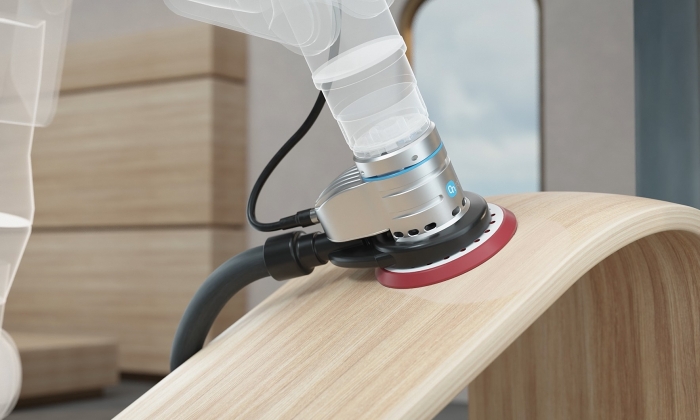Switching From Manual to Automated Sanding


Even when armed with the latest handheld sanding tools, manual sanding is a difficult, time-consuming and repetitive task that carries the added risk of causing repetitive strain injury, white finger syndrome or worse. At the same time, humans find it difficult to perform sanding tasks consistently throughout an entire shift, which leads to quality control issues with your finished product.
These issues make sanding an ideal task for automated sanding solutions, which will improve consistency and quality and reduce scrap rate. But what factors should you keep in mind when first thinking about investing in a robotic sanding system?
Focus on the application
Firstly, it's important to focus on a specific manual sanding task that you wish to automate. Break the process down into its constituent parts and consider which elements could be automated. Repeat this process for different sanding tasks and you'll have a useful set of criteria to work with when it comes to evaluating your automation options. Further questions to consider during this phase, include: Do you need heavy-duty sanding work done? Will you be working on one type of product or on mixed batches? How much time and how many resources are currently dedicated to manual sanding tasks?
Understand your options
While robots outperform humans when it comes to sanding tasks, remember that not all robotic sanding solutions are made equal. Automatic sanding machines, for example, have been in use for decades, but they are often expensive, difficult to program and have a large footprint. Although a proven fit for heavy-duty sanding tasks on single products in mass production environments, automated sanding machines remain too costly and bulky for most small to medium size companies.
Manufacturers specializing in high mix/low volume production runs will need a flexible solution that can quickly be redeployed to different products and sanding tasks, and in these cases, a collaborative sanding application is often the best fit.
Budgetary constraints
Traditional industrial robots with specialist sanding end-effectors provide excellent sanding performance, but they are also expensive and complicated to program, requiring expert integrators and robot coders to set up, adding further cost and complexity to the project. Collaborative robots are much more affordable than their traditional counterparts, making them a good fit for companies of all sizes and budgets. The additional features of collaborative sanding solutions make them a cost-effective, compelling choice for a wide range of surface finishing jobs.
Versatility
Lighter and smaller than traditional industrial robotic setups, collaborative solutions are easy to move around and redeploy for other purposes. Remember that not all collaborative sanding solutions deliver the same performance, with differences in functionality, cost and usability being important features to keep an eye on. Can the system handle different parts easily or is extensive downtime and programming involved? Is the sanding system also capable of handling grinding, cleaning and polishing tasks? Can the sanding end-effector support both flat and curved part geometries? Does the system come with all the hardware/software and accessories you need to get started quickly and with the minimum of cost and fuss?
Safety
Safety is key to most employers. While traditional robot applications require safety cages and extensive safety protocols, collaborative applications are designed for safer use around people. If you're looking for sanding automation that’s to be used in close proximity to human workers, then a collaborative sanding system is the most suitable choice.
In-house expertise
Evaluate the level of in-house robotics expertise in your facility. Can your existing in-house resources handle robot programming tasks? How much experience does your team have with robot operation and maintenance? How much training is required to become proficient on both the robot and the sanding tool? Will expert robot programmers have to be flown in every time there is an issue with the system?
Collaborative systems offer a real advantage here, as they usually easy to program, so always ask whether a setup can be operated by users with little or no prior robotics experience. If your company can handle robot programming (and major hardware investment), it might make sense to consider a traditional industrial robot – or an automated sanding machine – for your sanding processes.
Entering the market: Collaborative Electric Sander
OnRobot developed the OnRobot Sander to help manufacturers set up robotic sanding applications in the easiest possible way and at the lowest possible price. The OnRobot Sander offers the pathway of least resistance to sanding automation adoption. In terms of cost, ease of use, performance and versatility, it’s a ground-breaking product that combines unprecedented levels of usability with consistent sanding performance.
Designed to remove the barriers of cost and complexity often seen with competing sanding systems, OnRobot Sander's software is user-friendly and requires no previous robotics experience to operate. Hand-guiding features add to the intuitive programming experience, as it allows users to easily program the sanding tool by physically moving it where they want it to be and saving the position.
It’s a complete, out of the box solution that ships with a Plug & Produce sanding tool, a variety of standard sanding and polishing pads, easy-to-use programming software, an optional force/torque sensor and a grit changer that enables automated switching between different sanding grits without operator intervention. The OnRobot Sander offers all these features at a cost that won't break the bank and requires no robotics expertise to operate.
Ready to find out more about sanding automation? Talk to one of our experts about your sanding processes

|
如何通过协作式应用发展您的业务
随着更智能、适应性更强的工具的出现,机器人现在以更高的速度、强度、安全性和精度运行,能够完成广泛的任务,同时最大限度地提高投资回报率。通过下载我们的免费电子书,了解更多有关如何以更低成本实现更快生产的信息。
获取免费电子书
|

|

